
Hydrophilidae, also known colloquially as water scavenger beetles, is a family of beetles. Aquatic hydrophilids are notable for their long maxillary palps, which are longer than their antennae. Several of the former subfamilies of Hydrophilidae have recently been removed and elevated to family rank; Epimetopidae, Georissidae, Helophoridae, Hydrochidae, and Spercheidae. While the majority of hydrophilids are aquatic, around a third of described species are terrestrial, mostly belonging to the subfamily Sphaeridiinae.
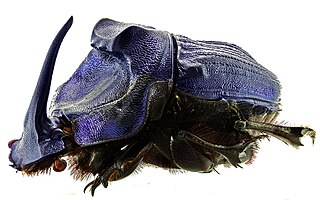
Coprophanaeus is a genus in the family Scarabaeidae. The genus is almost entirely Neotropical, with a single species, C. pluto, ranging into southernmost Texas in the United States. They are medium-sized to large beetles, with the South American C. ensifer and C. lancifer sometimes exceeding 5 cm (2 in) in length, making these two some of the largest dung beetles in the world and the largest in the Americas. They often have a horn on the head, and are typically a bright metallic color, most often blue or green, or black. These diurnal or crepuscular beetles are excellent diggers and good fliers.
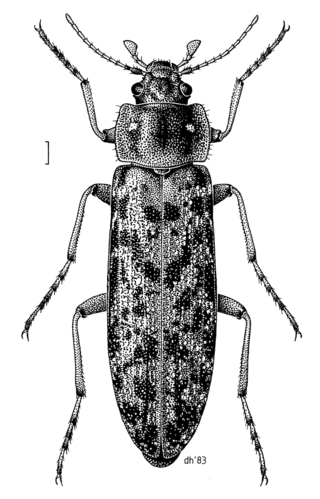
The Chalcodryidae are a family of beetles in the superfamily Tenebrionoidea. It contains at least five species in two genera Chalcodrya and Philpottia, which are endemic to New Zealand. They are generally found associated with moss or lichen covered branches, with the larvae having been found to be associated with dead twigs. It is thought that they are noctural, feeding on lichen and other plant material at night. The genera Sirrhas and Onysius, formerly placed in this family, have subsequently been transferred to Promecheilidae.
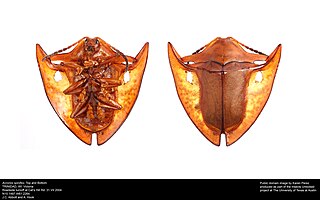
Acromis spinifex is a species of tortoise beetle from South America. The males have enlarged elytra which are probably used in male–male combat, while females are among the few tortoise beetles to show maternal care of their offspring.
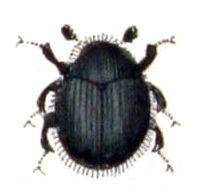
Chaetophora is a genus in the family Byrrhidae, the pill beetles.

The western Hercules beetle is a species of rhinoceros beetle that lives in Arizona, New Mexico and Utah in the United States and in parts of northern Mexico. This species is known for its grayish-white elytra, large size, and characteristic horn of the adult males.
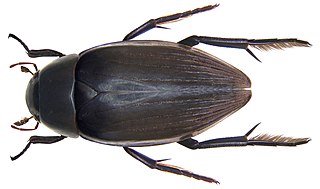
Hydrophilus is a genus of beetles in the family Hydrophilidae, the water scavenger beetles. There are 53 species in three subgenera in the genus: Hydrophilus, Dibolocelus, and Temnopterus.
Agabetes is a genus of beetles in the family Dytiscidae, containing the following species:

Sphaeridiinae is a subfamily of water scavenger beetles. Some species live in fresh water as both larvae and adults.

Pandeleteius is a genus of broad-nosed weevils in the family Curculionidae. There are over 150 described species in Pandeleteius, distributed across the Americas. Most species in the genus were described by Anne Howden.
Metaparia is a genus of leaf beetles in the subfamily Eumolpinae. There are nine described species in Metaparia, distributed from the United States to Central America.

Hydrophilus triangularis, known generally as the giant black water beetle or giant water scavenger, is a species of water scavenger beetle in the family Hydrophilidae. It is the most common and widespread species of Hydrophilus in North America, being found across the contiguous United States, southern Canada, and Mexico.
Metaparia viridimicans is a species of leaf beetle. It is found in the United States and Mexico.

Hydrophilus ovatus is a species of water scavenger beetle in the family Hydrophilidae. It is found in the eastern United States from Maine south to Florida and west to Texas and Kansas, southern Ontario and Quebec, and south to southern Mexico.
Hadromychus is a genus of handsome fungus beetles in the family Endomychidae. There is one described species in Hadromychus, H. chandleri.
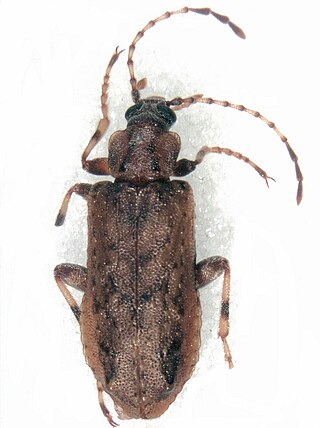
Promecheilidae is a family of beetles in the superfamily Tenebrionoidea. Perimylopidae is considered a synonym. They are found in southern South America and associated archipelagos like South Georgia and the Falklands, New Zealand and Tasmania. Some species are associated tree ferns and moss-covered dead wood, and other forested habitats, while others are associated with peat bogs, grasslands and coastal habitats. They are probably phytophagus, feeding on lichen, moss, and other plant material.
Egidyella arcana is a beetle species identified by William James Beal and Rustem Zhantiev in 2001. Egidyella arcana is part of the genus Egidyella and the meadows family. The Catalog of Life does not list any subspecies.

Hydrophilus insularis is a species of water scavenger beetle in the family Hydrophilidae. It is found from northern South America north throughout the Caribbean, Central America, and Mexico into southern Arizona, California, Texas, and Florida in the United States.
Pseudaspidimerus flaviceps, is a species of lady beetle native to India, and Sri Lanka.

Telegeusinae is a small subfamily of beetles in the family Omethidae recognizable by enlarged palpi found in males. Though relatively rare, males are sometimes found in large numbers in black light traps. Females are not known in this group, but it is theorized that females are larviform as found in many closely related taxa.













